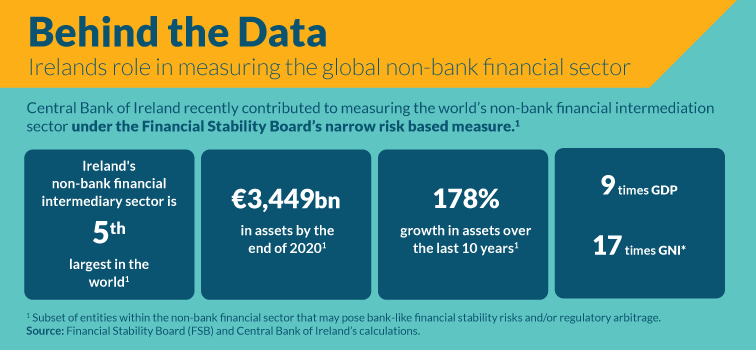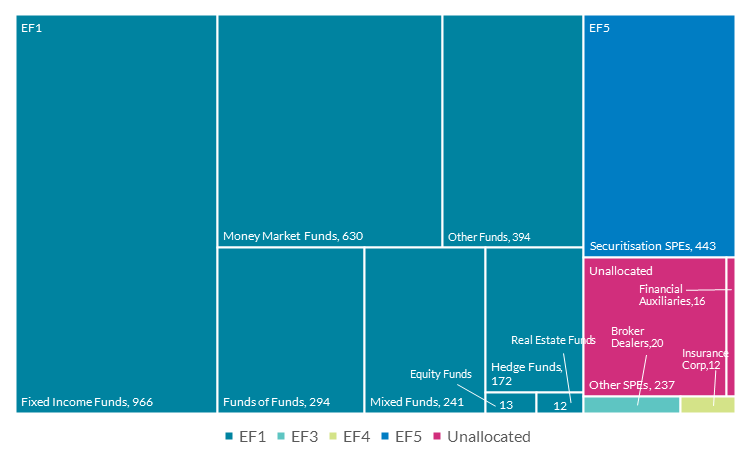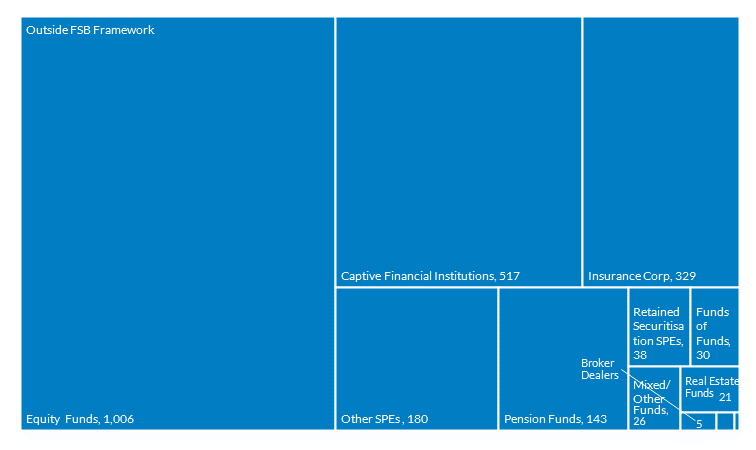Behind the Data

Beyond “Big”: Measuring Ireland’s Non-Bank Financial Intermediation Sector
Author Matteo Lai*
January 2022
Since 2011, the Financial Stability Board has undertaken an annual exercise to quantify the subset of entities within the global non-bank financial sector that may pose bank-like financial stability risks and/or regulatory arbitrage (“narrow measure”). Over the past decade, Ireland’s narrow measure almost tripled in size. The sector reached €3,449 billion by the end of 2020, making it the fifth largest in the world. In this Behind the Data we use granular data collected by the Central Bank to look beyond its size and reveal what types of activities and key characteristics led non-banks to be included in this measure.

The Financial Stability Board (FSB) introduced an annual global monitoring exercise for non-bank financial intermediaries (NBFI) in 2011 recognising the need for better monitoring of the sector following their role in the Global Financial Crisis, and concerns around regulatory gaps (FSB, 2011). The FSB has developed a specific framework to measure the non-bank financial intermediation, previously known as “shadow banking”. They aim to identify a subset of entities within the non-bank financial sector that may pose bank-like financial stability risks and/or regulatory arbitrage (the “FSB Framework”). This Behind the Data makes use of Central Bank of Ireland’s input into this exercise and the highly granular Central Bank statistics to profile in detail the subset of resident NBFI entities captured by this measure and featured in the Irish component of the FSB’s recent 2021 Global Monitoring Report.
The NBFI sector can offer an alternative source of finance or investment and diversify risk across both investors and countries (Cima, Killeen and Madouros, 2019 and Heffernan et al., 2021). However, like bank lending, it can pose risks to the stability of the financial system. In its latest Financial Stability Review, the Central Bank identified the continued growth in the size, interconnectedness and risk-taking activities within the non-bank financial sector as current risks that could further amplify the impact of negative financial shocks. A recent example is the withdrawal of cash from certain Irish-resident Money Market Funds (MMFs) during the financial market dislocation in March 2020. All MMFs were able to meet investor demands (Makhlouf, 2021), but, as liquidity pressures increased, MMFs sharply reduced their exposure to less liquid short-term debt securities, disrupting banks and other private companies', ability to fund themselves in short-term markets (Golden, 2020).
Analysis and surveillance of Ireland’s resident NBFI sector is therefore important from both a national and international perspective. Along with the Central Bank’s own Market Based Finance Monitor and the European Systemic Risk Board’s Non-bank Financial Intermediation Risk Monitor, the FSB’s annual Global Monitoring Framework supports these aims.
Benefiting from highly granular data, this Behind the Data aims to look beyond the scale of Ireland’s NBFI sector by shining a light on what types of activities lead non-banks to be classified as potential sources of bank-like risk under the FSB Framework. Using this classification, developments over time and an international comparison are also presented.
The Data
The annual monitoring exercise coordinated by the FSB assesses global trends across the G20 countries and 9 other countries, accounting for 80% of global GDP. The data feeding into the FSB’s narrow NBFI measure covers a subset of Ireland’s non-bank sector identified as engaging in credit intermediation activities that could pose bank-like financial stability risks and/or regulatory arbitrage. It uses Central Bank Quarterly Financial Accounts (QFA) and security-level granular data collected by the Central Bank on all Irish-resident investment funds, money market funds, and special purpose entities. The granularity of the data allows us to identify which non-bank institutions share similarities with banks (for instance, using short-term sources of finance to fund long-term investments/credit).
What kind of non-banks make up Ireland’s non-banks financial intermediation sector?
Following the methodology and classification guidance developed by the FSB, each year the Central Bank classifies financial institutions as NBFI that may pose risks to financial stability if they are outside the banking system, but engage in bank-like activities. While there are six possible categories or economic functions (FSB, 2013), this Behind the Data focuses on the three in which Irish non-banks are concentrated and covers 98.6% of the total Irish NBFI sector. They are:
- Being at risk of ‘bank-run’-like events (Economic Function 1, EF1).
- Engaging in securitisation (Economic Function 5, EF5).
- Non-banks providing credit to individuals and businesses, not captured elsewhere (Unallocated).
The first category comprises investment and money market funds which invest in debt securities (or other forms of credit) or have significant amounts of leverage. Such funds could be subject to ‘bank-run’-like events, in the event of a shock. If many investors simultaneously withdraw money from a fund, the fund may need to fire-sale assets and impact broader market conditions, which can in turn spur further withdrawals and so on (Mirza et al, 2020). This self-reinforcing dynamic can negatively impact financing conditions of companies', and governments as yields rise and markets conditions deteriorate (Falato et al, 2021).
The second category securitisation involves an entity issuing bonds backed by a portfolio of assets that it owns (usually loans). Securitisation supports bank lending by transferring existing loans and the associated risks off banks’ balance sheets, leading to lower collateral backed funding costs for banks. However, this also allows banks to lend more, which may lead to an excessively high level of debt for an economy. They can also pose financial stability risks if the securitisation is funded with short maturities, and may be difficult to renew in periods of market stress such as experienced in 2007-2009 (for a detailed overview of the sector in Ireland, see Golden and Hughes, 2018).
The remainder of Ireland’s NBFI sector is made up of non-banks providing credit to individuals and businesses, which are not captured by other categories', of NBFI (unallocated). This mainly consists of special purpose entities not involved in securitisation, which are companies; set up for a specific, usually narrow, financial purpose (i.e. raising finance for their parent company). They may finance companies; and individuals directly, or through a credit intermediation chain that includes other companies.
In total, under the FSB approach to measurement, the Irish NBFI sector has assets of €3,449bn. This is largely comprised of Economic Function 1 type investment funds (€2,092bn) and money market funds (€630bn). The rest of the NBFI sector is mostly made up of entities engaged in securitisation (€443bn) and non-securitisation special purpose entities providing credit to companies', and individuals (€237bn) (Chart 1).
The NBFI measure under the FSB Framework excludes a substantial portion of Ireland’s non-bank financial sector. It excludes insurance corporations (those not engaging significantly in credit insurance or credit derivative activity), pension funds, financial auxiliaries and other financial intermediaries (OFIs) which do not have financing structures or engage in activities which may pose risks to financial stability. The largest categories excluded are equity funds (€1,006bn), captive financial institutions (€517bn), insurance corporations (€329bn) (Chart 1).
Chart 1: Non-bank financial sector by economic function (Total Assets - € billion)
Under FSB Framework, €3,449bn
 Source: FSB and Central Bank of Ireland’s calculations.
Source: FSB and Central Bank of Ireland’s calculations.
Note: EF1: collective investment vehicles with features that make them susceptible to runs; EF3: market intermediation dependent on short-term funding; EF4: facilitation of credit intermediation; EF5: securitisation based credit intermediation; Unallocated: cannot be assigned to a specific economic function (other SPEs, financial auxiliaries)
Outside FSB Framework, €2,300bn
 Source: FSB and Central Bank of Ireland’s calculations.
Source: FSB and Central Bank of Ireland’s calculations.
Recent trends and how does Ireland rank internationally?
Over the past decade, Ireland’s NBFI sector (as defined by the FSB), which in 2020 accounted for around 60% of Ireland’s resident non-bank sector, has undergone a remarkable expansion. The sector almost tripled from €1,240bn at end-2010 to €3,449bn at end-2020 (Figure 2). This growth is primarily due to an increase in the investment fund industry, which saw its total assets increase by €1,753bn to €2,092bn over the last ten years. While this partly reflects asset revaluations common to other jurisdictions, investor inflows into an expanding Irish-resident investment fund sector have been consistently strong relative to other countries reflecting Ireland’s role as a host for international asset management activities (Cima, Killeen and Madouros, 2019).
Chart 2: Ireland’s NBFI components under FSB Framework (Total Assets)
.png?sfvrsn=4909931d_2)
Source: FSB and Central Bank of Ireland’s calculations
Note: The definition of non-banks that may pose bank-like financial stability risks and/or regulatory arbitrage is guided by the methodology developed by the FSB.
At the end of 2020, Ireland’s NBFI sector as defined by the FSB was the fifth largest in the world (Figure 3), after United States (€15,436bn), China (€7,596bn), Cayman Islands (€5,760bn), and Luxembourg (€3,940bn).
Although shares of each economic function vary across jurisdictions, funds at risk of ‘bank-run’-like events (Economic Function 1) constituted the largest portion (almost 77% within the top 10 Countries) of NBFI measures under the FSB Framework. Irish resident securitisation vehicles (Economic Function 5) and non-securitisation special purpose entities (Unallocated) were the third and second largest in the world respectively.
Chart 3: NBFI components under FSB Framework (Total Assets) - Top 10 Countries
---top-10-countries.png?sfvrsn=4b09931d_2)
Source: FSB and Central Bank of Ireland’s calculations.
Note: EF1: collective investment vehicles with features that make them susceptible to runs; EF2: loan provision that is typically dependent on short-term funding; EF3: market intermediation dependent on short-term funding; EF4: facilitation of credit intermediation; EF5: securitisation based credit intermediation; Unallocated: cannot be assigned to a specific economic function.
Relative to the size of the domestic economy, the Irish NBFI measure under the FSB Framework was around 9 times the GDP in 2020, ranking the third largest of such sectors after Cayman Islands (around 1,429 times the GDP) and Luxembourg (around 61 times the GDP). Using the modified Gross National Income (GNI*), the Irish figure jumps to around 17 times GNI*, highlighting Ireland’s position as an open economy with an internationally-focused non-bank financial system.
Conclusion
This Behind the Data delves deeper into the global FSB framework for estimating non-banks that may pose risks to financial stability and provides further context for Ireland’s contribution to the annual global monitoring exercise. It illustrates the granular data that is used to arrive at the results and it shows that Ireland’s NBFI sector as defined by the FSB is the fifth largest in the world and the third largest relative to the size of the domestic economy. Looking beyond the size of the sector, we shine a light on the key features and components of the three main categories of Ireland’s NBFI under the FSB Framework: funds holding debt securities which may be vulnerable to runs, securitisation vehicles and non-securitisation special purpose entities. Given Ireland’s position, monitoring NBFI activity (both within and outside the FSB exercise) is a core element of the Central Bank of Ireland’s approach to safeguarding financial stability at both a domestic and international level.
*Email [email protected] and [email protected] if you have any comments or questions on this note. Comments from Barra McCarthy, Brian Golden, Maria Woods, Peter Dunne, Jenny Osbourne Kinch, Rory McElligott and Kitty Moloney are gratefully acknowledged. The views expressed in this note are those of the authors and do not necessarily reflect the views of the Central Bank of Ireland or the ESCB.